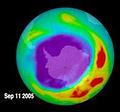 美國政府部門與一所大學的研究中心最新的報告指出,欲完全恢復南極的臭氧保護層,將需耗時比先前科學家所預測多出20年。這項利用數學運算為基礎的電腦模型能做出更準確的預測,臭氧層須至2068年才可復原,而非現在一般公認的2050年。
美國政府部門與一所大學的研究中心最新的報告指出,欲完全恢復南極的臭氧保護層,將需耗時比先前科學家所預測多出20年。這項利用數學運算為基礎的電腦模型能做出更準確的預測,臭氧層須至2068年才可復原,而非現在一般公認的2050年。
南極臭氧層破洞每年春天都造成南半球大氣層中的臭氧嚴重流失;近來,北極上空也出現一個較小的破洞。
美國太空總署科學家紐曼(Paul Newman)指出:「對於距離南北極較遠的地區,例如美國或非洲,臭氧的標準只低於自然值3%到6%;然而在南極地區,春季的臭氧值會降低70%。」
他表示,「新技術能更準確預測南極區的耗臭氧氣體的含量,並從這些氣體漸減的模式估算臭氧洞隨時間縮小的時程。」
這個模式精準呈現南極上空同溫層過去27年中臭氧洞演進歷程,科學家以此模式預測臭氧洞將在2068年恢復,而非目前普遍相信的2050年。
臭氧層破洞位在距地表15到50公里上方的同溫層中,肇因於空氣中的氯氣和溴氣被紫外光分解後,釋出氯原子或溴原子來分解臭氧。
這些耗臭氧氣體主要來自人類普遍使用的各種氟氯碳化物(CFC),例如冰箱冷煤、海龍(halons)滅火劑、乾洗溶劑中的四氯化碳、三氯乙烷(可用於黏著劑中的溶劑和金屬去污)和農藥中的甲基溴。
臭氧層吸收90%到99%的紫外光,保護地表免於紫外線直射。臭氧層破洞所造成的首要危機就是過量紫外線直射對人類健康和生態系統的影響。高紫外線環境使人們罹患皮膚癌和白內障的比例增加,過量紫外輻射(UV-B)肇使特定經濟作物產量下降,並抑制海洋表層浮游植物的活性,進而影響整個海洋生態。
根據1987年議定的「蒙特婁公約」,多國協議逐漸減少生產和使用耗氧氣體,以縮小臭氧層破洞,並終使臭氧層復原。
儘管蒙特婁公約已禁止製造大部分耗氧化合物,但美國太空總署(NASA)、國家海洋與大氣總署(NOAA)和美國國家氣象研究中心(NCAR)的研究員指出,臭氧層破洞至今尚未明顯縮小,這種緩慢的復原速度還要持續須至2018年,臭氧層才會開始加速恢復。
The full return of the protective ozone layer over the South Pole will take nearly 20 years longer than scientists had previously predicted, according to a new study from two U.S. government agencies and a university research center. A new math-based computer model can now better predict when the ozone hole will recover - in 2068, not in 2050 as currently believed.
The Antarctic ozone hole is a massive loss of ozone high in the atmosphere that occurs each spring in the Southern Hemisphere. A similar, smaller hole has more recently begun to appear over the Arctic as well.
"Over areas that are farther from the poles like Africa or the U.S., the levels of ozone are only three to six percent below natural levels. Over Antarctica, ozone levels are 70 percent lower in the spring," said Newman.
"This new method allows us to more accurately estimate ozone-depleting gases over Antarctica, and how they will decrease over time, reducing the ozone hole area," he said.
The model accurately reproduces the ozone hole area in the Antarctic stratosphere over the past 27 years. Using the model, the researchers predict that the ozone hole will recover in 2068, not in 2050 as currently believed.
The ozone hole in the atmosphere's stratospheric layer, between 15 and 50 kilometers (nine and 31 miles) above the Earth's surface, is caused by chlorine and bromine gases that destroy ozone.
These gases come from human-produced chemicals such as chlorofluorocarbons, or CFCs, used in refrigerants; halons, used in firefighting; the dry cleaning chemical carbon tetrachloride; and methyl chloroform, a solvent for adhesives and for metal degreasing; as well as methyl bromide, an agricultural fumigant and pesticide.
The ozone layer blocks 90 to 99 percent of the Sun's ultraviolet radiation from making contact with Earth.The primary concern over ozone depletion is the potential impacts on human health and ecosystems due to increased UV exposure. Increases in skin cancer and cataracts in human populations are expected in a higher UV environment. Lower yields of certain cash crops may result due to increased UV-B stress. Higher UV-B levels in the upper ocean layer may inhibit phytoplankton activities, which can impact the entire marine ecosystem.
The ozone layer is expected to improve based on a decrease in the production and consumption of ozone depleting gases mandated by an international treaty, the 1987 Montreal Protocol.
While the Montreal Protocol has banned the production of most chemicals that destroy ozone, the NASA, NOAA, and NCAR researchers show that the ozone hole has not started to shrink much as a result. The scientists predict the ozone hole will not start shrinking a lot until 2018, but by that year, the ozone hole's recovery will begin to accelerate.



